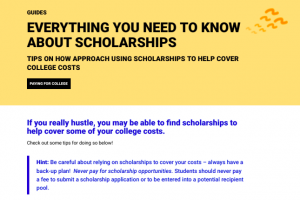
Do I Qualify For Financial Aid?
It’s normal to have questions about Financial aid, especially if you have never applied for it before. One of the most common questions is, “Do I qualify for financial aid?” There are many myths and misconceptions about who is eligible to receive financial aid, so it’s important to have all the facts when going through this process.
Why This Matters
In this context, financial aid refers to money for college provided by the federal government in the form of federal student loans, grants, and work-study jobs. Other types of financial aid include scholarships from your college or outside sources, and private student loans from banks or other institutions. These types of funding have their own eligibility requirements, which may or may not be connected to your eligibility for federal student aid.
The only way to know exactly what type of financial aid you qualify for is to complete the Free Application for Federal Student Aid (FAFSA). When you (or your parent, if you are a dependent) complete the FAFSA, you will enter personal financial information that is used to calculate an Expected Family Contribution (EFC). Your school’s financial aid office will use this number, along with the cost of attendance at the college or university, to determine what types of aid and how much money you are eligible to receive.
Even if you or your parents think that you are not eligible for any federal financial aid, it is important to complete the FAFSA each year. Individual schools and states use this information to determine eligibility for scholarships, grants, and other types of non-federal student aid. Sometimes things change, and where you didn’t qualify for financial aid last year, you qualify this year. Thanks to the online application process, and the IRS Data Retrieval Tool, completing the FAFSA is simpler and faster than ever.

Do I Qualify for Financial Aid?
To determine if you meet basic eligibility requirements for financial aid, ask yourself the following questions. Please note, these questions apply to the student, not the person completing the FAFSA, such as a parent or guardian.
Am I a U.S. citizen, or an eligible noncitizen?
You are considered an eligible noncitizen if you meet any of the following criteria:
- U.S. national (including natives of American Samoa or Swains Island)
- U.S. permanent resident with a Permanent Resident Card
- An individual who has an Arrival-Departure Record (I-94) from U.S. Citizenship and Immigration Services showing one of the following designations:
- Refugee
- Asylum Granted
- Cuban-Haitian Entrant (Status Pending)
- Conditional Entrant (valid only if issued prior to April 1, 1980)
- Victim of human trafficking
- Parolee (must be paroled into the United States for at least one year and you must be able to provide evidence from the USCIS that you are in the United States for other than a temporary purpose and that you intend to become a U.S. citizen or permanent resident.)
- “Battered immigrant-qualified alien” who is a victim of abuse by your citizen or permanent resident spouse, or you are the child of a person designated as such under the Violence Against Women Act (VAWA).
- A citizen of the Federated States of Micronesia, the Republic of the Marshall Islands, or the Republic of Palau. If this is the case, you may be eligible for only certain types of federal student aid:
- Citizens of the Republic of Palau are eligible for Federal Pell Grants, Federal Supplemental Educational Opportunity Grants, and Federal Work-Study.
- Citizens of the Federal States of Micronesia and the Republic of the Marshall Islands are eligible for Federal Pell Grants only.
Do I demonstrate financial need?
In this case, “financial need” is defined as the difference between the cost of attendance at a school, and your Student Aid Index (SAI). Your SAI is calculated based on your FAFSA, and remains the same regardless of the cost of attendance at the school you choose.
The SAI is a measure of you or your family’s financial strength. It’s based on taxed and untaxed income, assets, and benefits such as unemployment or Social Security. Due to changes implemented as part of the FAFSA Simplification Act, the SAI will no longer include the number of students a family currently has in college as part of its calculations, as the EFC did.
Each individual school will calculate your aid eligibility by subtracting your SAI from the school’s cost of attendance (COA). This is why it’s important to send your completed FAFSA to all the schools you are considering attending, as your financial aid eligibility will vary from school to school.
Based on your demonstrated financial need, the school will create a financial aid package informing you of how much and what types of aid you can receive.
Am I enrolling in a degree or certificate program at an eligible school?
The institution and type of program in which you are enrolling also affects whether you qualify for financial aid.
In accordance with the Higher Education Act, which established federal financial aid programs, there are certain guidelines institutions must meet in order to receive financial aid benefits for students. Institutions must have accreditation from a nationally recognized accrediting agency, or approval from a recognized state approval agency, in the case of certain vocational schools. Schools must also be authorized by the state in which they are located, and receive approval from the U.S. Department of Education through a program participation agreement.
The individual program in which you are enrolling matters, too. Degree and certificate programs must be approved by the U.S. Department of Education, be longer than one year in length, and lead to gainful employment in order for students to receive financial aid to pay for those programs. During your college search process, you should confirm that the school and program you are interested in attending is eligible for financial aid.
Additional Qualifications for Financial Aid
In addition to the basic eligibility criteria, students must also meet the following qualifications:
- Have a valid Social Security Number (if you are a U.S. citizen) – Students from the Republic of the Marshall Islands, the Federated States of Micronesia, and the Republic of Palau are exempt from this requirement.
- Demonstrated eligibility to obtain a college or career school education – This means students must have a high school diploma, or a recognized equivalent, such as a General Educational Development (GED) certificate, or have completed high school in an approved homeschool setting. Students who were enrolled in college or career school prior to July 1, 2012, or are currently enrolled in an eligible career pathway program may show they’re qualified to obtain a higher education by passing an approved ability-to-benefit test (if you don’t have a diploma or GED, a college can administer a test to determine whether you can benefit from the education offered at that school) or completing six credit hours, 225 clock hours, or equivalent course work toward a degree or certificate.
- Sign the certification statement on the FAFSA – This confirms that you are not currently in default on any federal student loans, that you do not currently owe money on a federal student grant, and that you will use your federal student aid for educational purposes only.
- Maintain satisfactory academic progress – Once you are enrolled in college or career school, you must remain in good academic standing and meet your school’s standards for satisfactory academic progress to continue receiving financial aid.
- Submit a new FAFSA each year – Your financial aid eligibility, as determined by your FAFSA, is only valid for one academic year. Students or their parents must submit a new, updated FAFSA for each year that they want to receive financial aid. FAFSA deadlines vary by college and state, so it’s important to be aware of any FAFSA deadlines that apply to you.
Special Circumstances
Students in the following special circumstances may or may not qualify for financial aid, or may need to meet additional eligibility requirements:
Additional Resources
Resources provided by:










